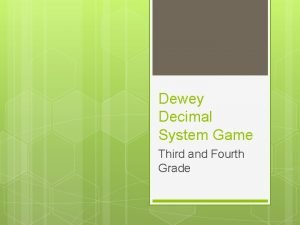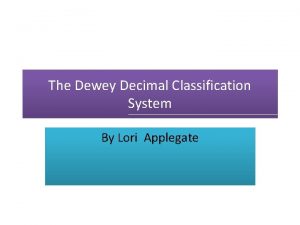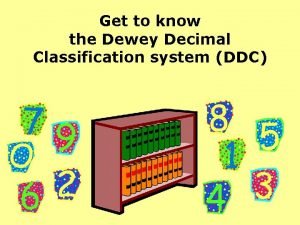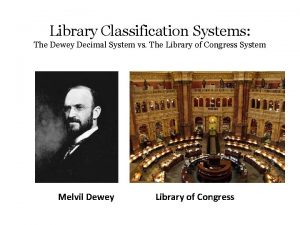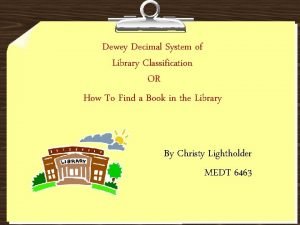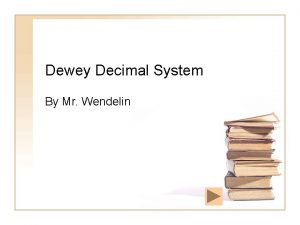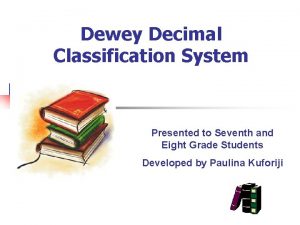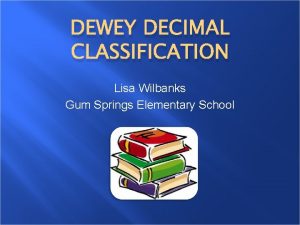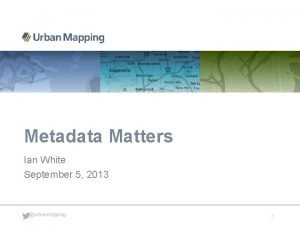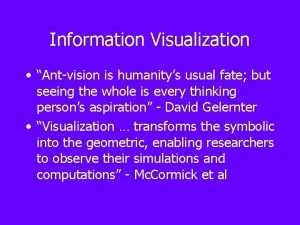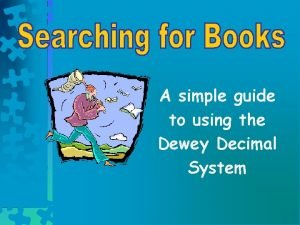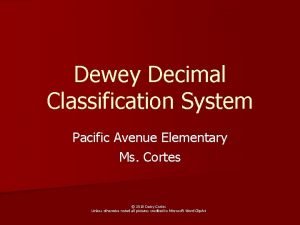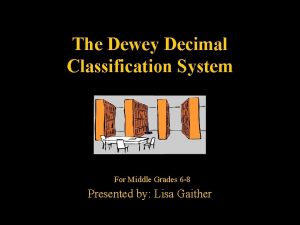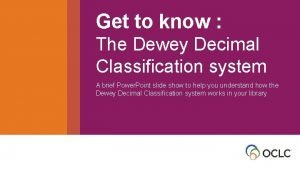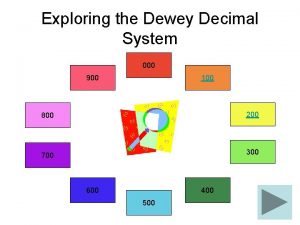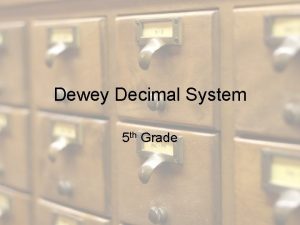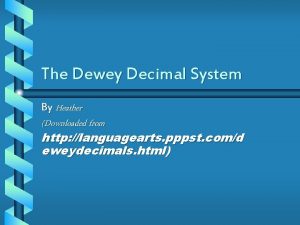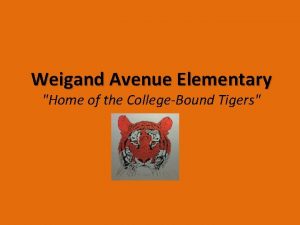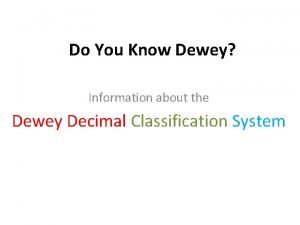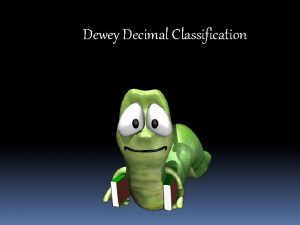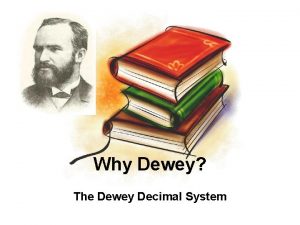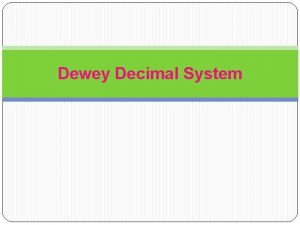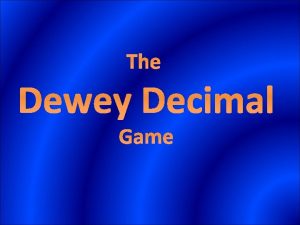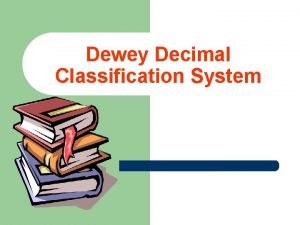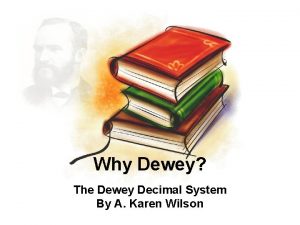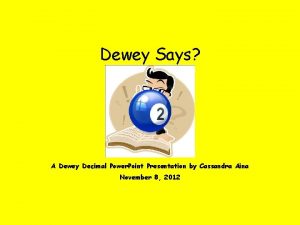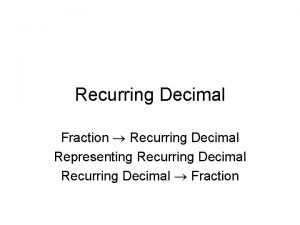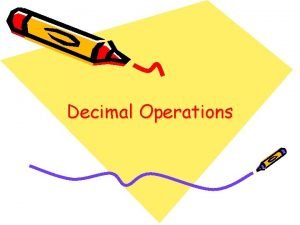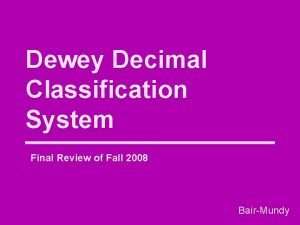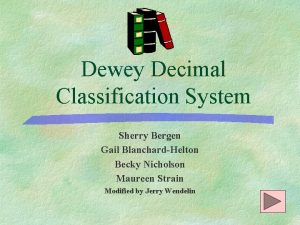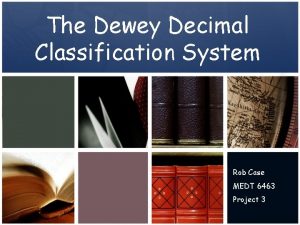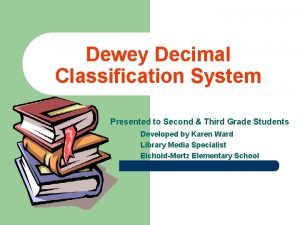Dewey Decimal Classification System Pacific Avenue Elementary Ms






















- Slides: 22

Dewey Decimal Classification System Pacific Avenue Elementary Ms. Cortes © 2010 Daisy Cortes Unless otherwise noted all pictures credited to Microsoft Word Clip. Art

What is the DDC? n n DDC- Dewey Decimal Classification System It’s the way we organize non-fiction books in a library School & public libraries use the DDC Libraries at universities use a different system called Library of Congress- LC Image from: http: //www. columbia. k 12. mo. us/dre/deweydirectory. html

Who invented the DDC? n n n Melville (Melvil) Dewey 1851 -1931 He was a librarian He wanted libraries to be free for everyone! He created a way to organize books.

The Dewey Decimal System n There are 10 main classes/categories (100 s, 200 s, 300 s…) n It is only for the non-fiction section

Generalities 000 -099 n Computers n Encyclopedias n Libraries

100 -199 Philosophy & Psychology n Thinking & Feelings n Friendship n Remember these are books about facts! – You won’t find stories about friendship here.

200 -299 Religion n Religious stories n Mythology

300 -399 Social Sciences n Social Sciences- these books are about how people live in the world n Government n Military n Holidays n Folk & Fairy Tales- WHAT? ? !!! Those are fiction books.

Fiction in Non-Fiction? n Some books in the non-fiction section are fiction books (made up stories) n Folk & Fairy Tales in the 300 s are fiction stories. Many times they tell us about legends or famous stories like Little Red Riding Hood

Fiction in Non-Fiction? n The Upstairs Room by Johanna Reiss n Fiction because most of the characters are not real people. n It is in the 900 s because the setting is World War II a big part of US History.

400 -499 Language n Different Languages n Sign Language n Dictionaries n We don’t have a lot of these books in our library. Visit your public library!

500 -599 Natural Sciences n Natural Science is how nature is found (unbothered by humans) n Planets & Stars n Earthquakes, Volcanoes, Tsunamis n Dinosaurs n Botany= plants n Animals & Bugs

600 -699 Applied Science n Applied Science is how humans use nature or thought n Inventions n Health n Transportation n Pets n Cooking

500 s vs. 600 s What’s the difference? 500 s Natural Science n 600 s Applied Science n Trees are Natural Science n USING a tree to make it into paper or a Applied Science house makes it Applied Science n

500 s vs. 600 s n 500 s Natural Science n 600 s Applied Science n A coyote would be found in Natural Science. It is a wild animal. n A dog would be found in Applied Science. Humans took dogs and made them into pets.

Animals in 600 s n Domesticated Animals n Domesticated- to tame; animals that live closely with humans n Farm Animals & Pets – Horses, Cows, Chickens, Cats, Dogs, etc

700 -799 Arts & Recreation n Arts- drawing, music, painting etc n Recreation- things we do for fun, games – Sports – Magic

800 -899 Literature n Poetry n Jokes & Riddles

900 -999 History & Geography n Atlases & Maps n Country books n Ancient Civilizations n Wars n Presidents

What is a call number? n. A call number tells you where a book goes in the library. (It’s like an address) n It is located on the spine of a book Call Number

How are books organized? FICTION n Author’s last name n Ex n – Diary of a Wimpy Kid’s author is Jeff Kinney – The call number will look like this: FIC KIN NON-FICTION n DDC number and author’s last name n Ex n – Elephants by Roland Smith – The call number will look like this: 599. 67 SMI

How do we look for books on the shelf? LR TB Left to Right Top to Bottom
 Dewey decimal game
Dewey decimal game Dewey decimal classification system definition
Dewey decimal classification system definition 1876 dewey decimal system was introduced
1876 dewey decimal system was introduced Dewey decimal sustem
Dewey decimal sustem Dewey decimal system 813
Dewey decimal system 813 Dewey decimal system
Dewey decimal system Printable dewey decimal system
Printable dewey decimal system Dewey decimal system 400-499
Dewey decimal system 400-499 000-099 dewey decimal system
000-099 dewey decimal system Dewey decimal system
Dewey decimal system Dewey decimal system
Dewey decimal system Dewey decimal system
Dewey decimal system Dewey decimal system 700s
Dewey decimal system 700s 600-699 dewey decimal system
600-699 dewey decimal system Dewey decimal 700's
Dewey decimal 700's Gardening dewey decimal
Gardening dewey decimal Dewey decimal system 700
Dewey decimal system 700 Dewey decimal 700's
Dewey decimal 700's Dewey decimal system clipart
Dewey decimal system clipart Weigand avenue elementary
Weigand avenue elementary Dewey decimal dinosaurs
Dewey decimal dinosaurs Dewey decimal
Dewey decimal 636 dewey decimal
636 dewey decimal
